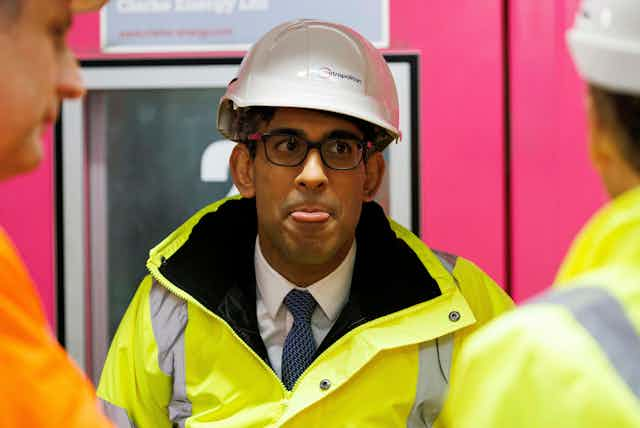UK prime minister Rishi Sunak has announced a major reorganisation of Whitehall, creating a new department dedicated to energy and another for science and innovation as well bringing various business and trade portfolios under one roof.
Reorganisations of this kind tell voters a great deal about the government of the day and its priorities. Sunak’s announcements are revealing not only as signals of his aims ahead of the next election but also of the pressures he faces.
The life and times of a department
The evolution of the departments dealing with housing over the years is a case study in how priorities are reflected in departmental reorganisation, and can help us understand what is going on now.
Clement Attlee’s Labour government created a Ministry of Local Government and Planning in 1950, at a time when housing was needed and local authorities were determined as the obvious landlords.
The following year, the department was renamed “Housing and Local Government” by the Conservatives. This was clearly linked with the Conservative promise to supercharge housebuilding.
This ministry lasted until 1969, when it was renamed first by Labour and again a year later by Ted Heath in a merger that included the Ministry for Transport and the Ministry for Public Buildings and Works. Together, they all became the Department of the Environment. Priorities had shifted from construction to management of the overall urban environment.
In the 50 years that followed, multiple prime ministers rejigged housing and planning to reflect their various agendas. This includes the 2021 addition of “levelling up” to its title. Before that, Theresa May’s 2018 rebranding of the Department for Communities and Local Government as a Ministry of Housing, Communities and Local Government reflected the growing political significance of the housing crisis. Her decision also demonstrates that priorities can be cyclical as well as linear.
A new energy security department
Of course, there is more to Sunak’s choices than meets the eye. The creation of the Department for Energy Security and Net Zero, to be led by experienced minister Grant Shapps, shows how Rishi Sunak is seeking to unite the more progressive elements of the Conservative coalition (who support net zero) with those who see the most pressing energy issues as being related to the war in Ukraine and the associated price spikes.
Two previous premiers have created standalone energy departments. Heath established one in 1974 during an energy crisis that was hitting households in similar ways to the current situation. Gordon Brown set up the Department of Energy and Climate Change in 2008, which lasted until 2016 when May dissolved it.
Neither Heath nor Brown reaped any electoral benefit from their signalled commitment to energy issues, and the same may well be true for Sunak. The new department is perhaps more important in relation to how it ties the priorities of different Conservative groups together. This is a careful attempt to elide two seemingly contradictory agendas that centre on energy production.
Sunak is reshaping his cabinet to present a unified vision from a party disunited over how to address the climate emergency, while simultaneously showing awareness of difficult economic circumstances. In many ways, this is institutional reform as gymnastics.

Sunak has also recreated a ministry overseeing science, innovation and technology under newly appointed minister Michelle Donelan. With the underlying themes of modernity and future, a science department allows Sunak to project a forward-thinking government.
He is not the first to try to incorporate government engagement with these important agendas through rearranging departments. Harold Wilson created the Ministry of Technology in 1964 to tap into excitement created by his “white heat of technology” speech. Brown created the Department for Innovation, Universities and Skills with a similar goal in mind – although he subsequently subjected the department to numerous rebrands and mergers.
Whether Sunak will succeed here is again questionable. As much as anything else, the new department is perhaps recognition that the Conservative party, 13 years into government, is worried about the perception that it has not delivered on these agendas.
The merging of two departments into the new Department for Business and Trade, meanwhile, effectively recreates the old Department of Trade and Industry (DTI) – which was itself created twice (1970 and 1983) by Conservative prime ministers before being split up or refocused by Labour. It also marks the end of the short-lived Department for International Trade, created by May as part of her bid to establish “Global Britain” in the wake of Brexit.
Sunak’s decision to axe her department suggests that the existence of two ministries dealing with trade and business has perhaps hampered the government’s ability to engage properly with industry.
Why reorganise?
Government reorganisations are more than deckchair rearrangements or market-friendly rebranding. They reflect the assumptions, priorities and choices that constrain government policy. They elaborate the ideas and political concerns influencing those who govern. They even explain internal power relations and the fluctuating influence of individuals.
Many of these changes are designed to combat criticism. Together with Sunak’s recent announcement of his “five priorities”, they are designed to arrest a sense of drift. After recent resignations and potential trouble over bullying accusations directed at his deputy, Sunak is trying to unite his party behind a coherent programme – with appropriate government machinery to deliver it.
Unfortunately, history suggests that such improvisation often begets transient ministerial departments that only last for a short while, until the next major crisis. Sunak may simply be repeating the mistakes of both recent and other past premiers.
He is trying to give his government direction and fresh purpose, to extend its life and relevance. But instead of constant change in Whitehall, what is needed are resilient units that can be repurposed to suit changing political priorities.

